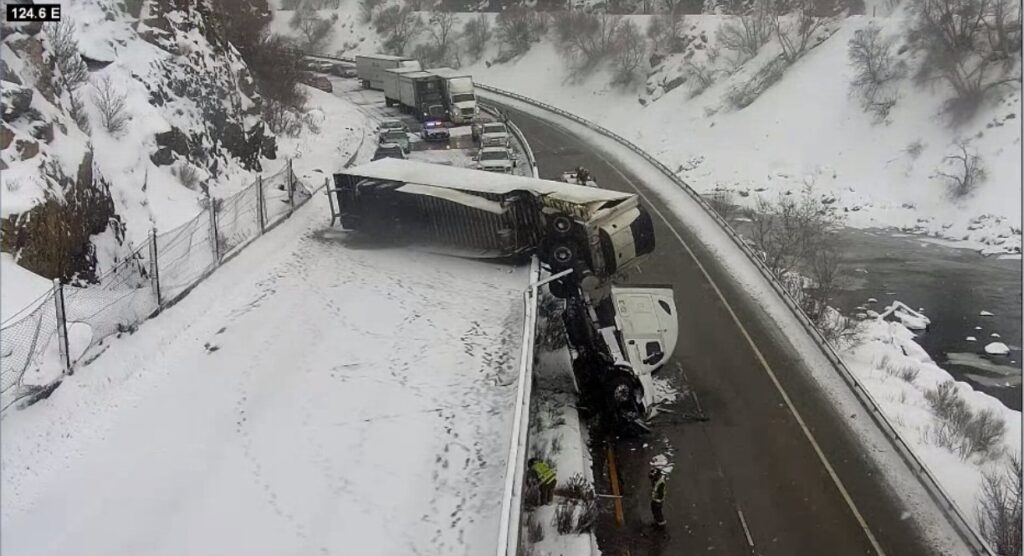
Pavement markers noting a prohibition on semi trucks driving on Interstate 70’s passing lane through Glenwood Canyon are the latest addition to a push aimed at reducing road closures.
Highway closures have been an oft-discussed topic for Western Slope leaders since mudslides forced a prolonged closure of the road in 2021, with many pointing to the economic impacts of extended closures. The Colorado Department of Transportation estimates approximately $1 million is lost for every hour Interstate 70 is closed through the central mountains.
While acts of nature had officials calling for alternative routes on tricky roads, winter crashes involving commercial vehicles have also yielded numerous lengthy closures — including a 2022 delay that drew interest after a man posted a video of him catching a fish from a bridge spanning the Colorado River while waiting for the wreck to clear.
Elise Thatcher, Northwestern Colorado communications manager for the Colorado Department of Transportation, says increased safety for commercial vehicles is a point of emphasis.

“We have had several extended closures due to crashes in the canyon in the last few years. Many of those had CMVs, or commercial motor vehicles, involved in those crashes. And so a key part of the goal here is to help truck drivers understand what it's like driving through the canyon,” Thatcher said. “They need to know that there's sharp curves, that they're not going to be able to change lanes quickly. They need to stay in the correct lane and they need to follow the correct speed and they need to be aware for sharp turns.”
The string of closures became so prevalent that Western Slope residents had to start working it into their plans, Glenwood Springs Mayor Ingrid Wussow said.
“We were all getting so gun shy that if we were traveling outside of Colorado or coming from the Front Range into Glenwood, hours before we left, we would be checking the canyon to see if it was closed,” Wussow said. “It was so frequent in the last few years and we haven't had that in the last few months.”
Wussow was among the local leaders to meet with CDOT officials in February to discuss solutions. There have been calls around the region for a route over Cottonwood Pass, which would be expensive and difficult to build. Two highways that are used as detour routes when Glenwood Canyon is closed — Colorado Highway 13 between Rifle and Meeker and U.S. Highway 50 between Montrose and Gunnison — have both seen significant investment that include safety improvements. But, Wussow said, she’s encouraged by the initial steps to slow down drivers on I-70.
“I grew up in Glenwood Springs, and I don't remember as a kid the canyon getting closed nearly as often as it has in the last few years,” Wussow said. “It's the behavior of drivers that is resulting in so many crashes.”
It’s too early to say if the changes are working, Thatcher said, but crashes are down. Before this addition, CDOT installed variable speed limit signs that allow them to adjust speed limits to conditions. They’ve also used “pacing vehicles” at points to dictate traffic speeds.
“By having either plows or a couple of our trucks at the beginning of each wave of traffic going that lowered speed limit we can help make sure folks are making good choices as they travel through the canyon,” Thatcher said.
CDOT has also made changes to better respond when there are accidents in the canyon. In the past, equipment for recovering or moving damaged vehicles had to come in from nearby areas like Glenwood Springs or Eagle. Now they’re staged around the canyon to clear wrecks and open the highway faster.
“We already saw significant benefits from that. I think it was late last spring going into the summer where we had some extended closures due to crashes that we were able to cut the time in approximately half or so,” Thatcher said. “Since we had that heavy equipment, we could quickly get to the crash, move the crash vehicle to the side — in this case it was a tractor trailer — and then reopened one lane so that travelers could get moving through the canyon again.”








